Consolidated B-24 Liberator
| B-24 Liberator | |
|---|---|

| |
| United States Army Air Forces Consolidated B-24D Liberator over Maxwell Field, Alabama. | |
| Role | Heavy bomber |
| Manufacturer | Consolidated Aircraft |
| First flight | 29 December 1939 |
| Introduction | 1941 |
| Retired | 1968 Indian Air Force[1] |
| Primary users | United States Army Air Forces United States Navy Royal Air Force Royal Canadian Air Force |
| Produced | 1940–1945 |
| Number built | 18,482 |
| Developed from | Consolidated XB-24 |
| Variants | PB4Y Privateer XB-41 C-87 Liberator Express Consolidated R2Y Consolidated Liberator I |
The Consolidated B-24 Liberator was an American heavy bomber, designed by Consolidated Aircraft of San Diego, California. It was known within the company as the Model 32, and a small number of early models were sold under the name LB-30, for Land Bomber. The B-24 was used in World War II by several Allied air forces and navies, and by every branch of the American armed forces during the war, attaining a distinguished war record with its operations in the Western European, Pacific, Mediterranean, and China-Burma-India Theaters.
Background
Mass production was brought into full force by 1943 with the aid of the Ford Motor Company through its newly constructed Willow Run facility, where peak production had reached one B-24 per hour and 650 per month in 1944.[2] Other factories soon followed. The B-24 ended World War II as the most produced Allied heavy bomber in history, and the most produced American military aircraft at over 18,400 units, due largely to Henry Ford and the harnessing of American industry.[3] It still holds the distinction as the most-produced American military aircraft.
Often compared with the better-known Boeing B-17 Flying Fortress, the B-24 was a more modern design with a higher top speed, greater range, and a heavier bomb load; however, it was also more difficult to fly, with heavy control forces and poor formation-flying characteristics. Popular opinion among aircrews and general staffs tended to favor the B-17's rugged qualities above all other considerations in the European Theater.[4] The placement of the B-24's fuel tanks throughout the upper fuselage and its lightweight construction, designed to increase range and optimize assembly line production, made the aircraft vulnerable to battle damage.[5] The B-24 was notorious among American aircrews for its tendency to catch fire. Moreover, its high fuselage-mounted "Davis wing" also meant it was dangerous to ditch or belly land, since the fuselage tended to break apart.[6] Nevertheless, the B-24 provided excellent service in a variety of roles thanks to its large payload and long range.
The B-24's most infamous mission was the low-level strike against the Ploiești oil fields, in Romania on 1 August 1943, which turned into a disaster because the enemy was underestimated, fully alerted and attackers disorganized.[6]
Development
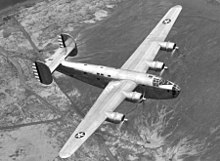
The Liberator originated from a United States Army Air Corps (USAAC) request in 1938 for Consolidated to produce the B-17 under license. After company executives including President Reuben Fleet visited the Boeing factory in Seattle, Washington, Consolidated decided instead to submit a more modern design of its own.[7]
Specifications
The new Model 32 combined the Davis wing, a high efficiency airfoil design created by unorthodox means by a lone inventor named David Davis,[8] the twin tail design from the Consolidated Model 31 flying boat, and mated both together on a new fuselage. This new fuselage was intentionally designed around the twin bomb bays, each one being the same size and capacity of the B-17.
In January 1939, the USAAC, under Specification C-212, formally invited Consolidated[9] to submit a design study for a bomber with longer range, higher speed, and greater ceiling than the B-17. The specification was written such that the Model 32 would automatically be the winning design. The program was run under the umbrella group running "Project A", an Air Corps requirement for an intercontinental bomber that had been conceived in the mid-1930s. Although the B-24 did not meet Project A goals, it was a step in that direction. Project A led to the development of the Boeing B-29 and Consolidated's own B-32 and B-36.[10]
Contract
The contract for a prototype was awarded in March 1939, with the requirement that one should be ready before the end of the year. The design was simple in concept but nevertheless advanced for its time. Compared to the B-17, the proposed Model 32 had a shorter fuselage and 25% less wing area, but had a 6 ft (1.8 m) greater wingspan and a substantially larger carrying capacity, as well as a distinctive twin tail. Whereas the B-17 used 9-cylinder Wright R-1820 Cyclone engines, the Consolidated design used twin-row, 14-cylinder Pratt & Whitney R-1830 "Twin Wasp" radials of 1,000 hp (746 kW). The 70,547 lb (32,000 kg) maximum takeoff weight was one of the highest of the period. Consolidated incorporated innovative features: the new design would be the first American bomber to use tricycle landing gear, and it had long, thin wings with the efficient "Davis" high aspect ratio design (also used on the projected Model 31 twin-engined commercial flying boat)[11] promising to provide maximum fuel efficiency. Wind tunnel testing and experimental programs using an existing Consolidated Model 31 provided extensive data on the flight characteristics of the Davis airfoil.[12]
Early orders—placed before the XB-24 had flown—included 36 for the USAAC, 120 for the French Armée de l'Air and 164 for the Royal Air Force (RAF). The name "Liberator" was originally assigned to it by the RAF, and subsequently adopted by the USAAF as the official name for the type.[13] When France fell in 1940, their aircraft were re-directed to the RAF.
Prototypes
Consolidated finished the prototype, by then known as the XB-24, and had it ready for its first flight two days before the end of 1939. After initial testing, the XB-24 was found to be deficient in several areas. One major failure of the prototype was that it failed to meet the top speed requirements specified in the contract. As built, the XB-24 top speed was only 273 mph instead of the specified 311 mph. As a result, the mechanically supercharged Pratt & Whitney R-1830-33s were replaced with the turbo-supercharged R-1830s. Additionally, the tail span was widened by 2 feet (0.61 m) and the pitot-static probes were relocated from the wings to the fuselage. The XB-24 was then redesigned XB-24B – these changes became standard on all B-24’s built starting with the B-24C model.

The USAAC initially ordered seven YB-24s under CAC contract # 12464 in April 1939, but like the prototype these aircraft were being built by hand and were not considered combat ready. The first six YB-24 were released for direct purchase under CAC contract # F-677 on 9 November 1940. These aircraft were redesignated LB-30A. The seventh aircraft was used by Consolidated and the USAAC to test armor installations as well as self-sealing fuel tanks. Initially, these aircraft were to be given USAAC serials 39-618 to 39-687. Due to delays with the actual purchase, however, the serial numbers were changed to 40-696 to 40-702. When the RAF purchased the first 6 YB-24 aircraft, the serial numbers were reassigned to a later block of B-24Ds.
The RAF, like the USAAC, found the LB-30As unsuitable for combat and had them assigned to the transatlantic Ferry Service between Canada and Prestwick, Scotland. The aircraft were all modified in Montreal for non-combat use. Changes included the removal of all armaments, provision for passenger seating, and a revised cabin oxygen & heating system.
Design
The B-24's spacious, slab-sided fuselage (which earned the aircraft the nickname "Flying Boxcar")[14] was built around a central bomb bay with two compartments that could accommodate up to 8,000 lb (3,629 kg) of ordnance each. The bomb bay was divided into front and rear compartments and had a central catwalk just nine inches wide,[15] which was also the fuselage keel beam. A universal complaint arose over the extremely narrow catwalk. The aircraft was sometimes disparaged as "The Flying Coffin" because the only entry and exit from the bomber was in the rear and it was almost impossible for the flight crew and nose gunner to get from the flight deck to the rear when wearing parachutes. An unusual set of "roller-type" bomb bay doors, which operated very much like the movable enclosure of a rolltop desk, retracted into the fuselage, creating a minimum of aerodynamic drag to keep speed high over the target area.[16]
Like the B-17, the B-24 had an array of .50 caliber (12.7 mm) M2 Browning machine guns in the tail, belly, top, sides and nose to defend it from attacking enemy fighters. However, unlike the B-17, the ball turret could be retracted into the fuselage when not in use, a necessity given the low ground clearance of the fuselage. The ball turret first appeared on B-24Ds sometime in early 1943 but not before the early Ds had used tunnel guns and the Bendix remote controlled turret. General use of the ball turrets by the U.S. would last until late July 1944 when performance gains outweighed the need for 360 degree belly defense. Bomber command Liberators generally dispensed with the belly turrets as unnecessary in areas where no enemy fighter presence would be found.
Operational history
Initial deployment
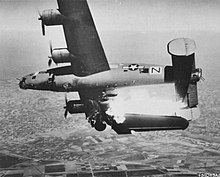
Liberator GR Is in British service were the first B-24s to be used operationally. The very first use of Liberators in British service was the use of ex-USAAF YB-24s (designated LB-30A), which while not suitable for combat, were used as a long-range transport, operating the Atlantic Return Ferry Service, returning the civilian ferry pilots who delivered aircraft such as the Lockheed Hudson across the Atlantic back to Canada. The most important role for the first batch of the Liberator GR Is was in service with RAF Coastal Command on anti-submarine patrols in the Battle of the Atlantic.[17]
Later in 1941, the first Liberator IIs entered RAF service. This model introduced self-sealing fuel tanks and powered gun turrets. At the same time, Consolidated added a 2 ft 7 in (79 cm) plug in the forward fuselage to create more space for crew members. The Liberator IIs were divided between Coastal Command, Bomber Command, and BOAC. Two RAF squadrons with Liberators were deployed to the Middle East in early 1942, in the first use of the Liberator as a bomber.[18]
America enters the war
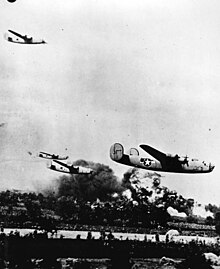
The United States Army Air Forces (USAAF) took delivery of its first B-24As in 1941. The sole B-24 in Hawaii was destroyed by the Japanese attack on Pearl Harbor on 7 December 1941. Like the RAF, the USAAF used them as transports at first. American B-24s entered combat service in 1942 when on 6 June, four B-24s from Hawaii staging through Midway Island attempted an attack on Wake Island, but were unable to find it.[19] On 12 June 1942, 13 B-24s flying from Egypt attacked the Axis-controlled oil fields and refineries around Ploiești, Romania.
Over the next three years, B-24 squadrons deployed to all theaters of the war: African, European, China-Burma-India, the Battle of the Atlantic, the Southwest Pacific Theater and the Pacific Theater. In the Pacific, the B-24 (and its twin, the U.S. Navy PB4Y Privateer) was eventually designated as the standard heavy bomber to simplify logistics and to take advantage of their longer range, replacing the shorter-range B-17 which had served early in the war along the perimeter of the Pacific from the Philippines, Australia, Espiritu Santo, Guadalcanal, Hawaii, and during the Battle of Midway from Midway Island.
War-time production
Continued development work by Consolidated produced a handful of transitional B-24Cs with turbocharged instead of supercharged engines. The turbocharged engines led to the flattened oval nacelles that distinguished all subsequent Liberator models.
The first mass-produced model was the B-24D (Liberator III in British service), entering service in early 1943. It had turbocharged engines and increased fuel capacity. Three more 0.50 caliber (12.7 mm) machine guns brought the defensive armament up to 10 machine guns. At 59,524 lb (27,000 kg) maximum takeoff weight, it was one of the heaviest aircraft in the world; comparable with the British "heavies" the Stirling, Lancaster and Halifax.[citation needed]
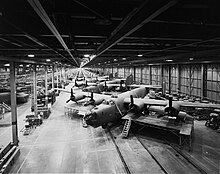
Production of B-24s increased at an astonishing rate throughout 1942 and 1943. Consolidated Aircraft tripled the size of its plant in San Diego and built a large new plant outside Fort Worth, Texas. More B-24s were built by Douglas Aircraft in Tulsa, Oklahoma. North American Aviation built a plant in Dallas, Texas, which produced B-24Gs and B-24Js.[citation needed] None of these were minor operations, but they were dwarfed by the vast new purpose-built factory constructed by the Ford Motor Company at Willow Run near Detroit, Michigan. Ford broke ground on Willow Run in the spring of 1941, with the first plane coming off the line in October 1942. It had the largest assembly line in the world (3,500,000 ft²/330,000 m²). At its peak, the Willow Run plant produced 650 B-24s per month in 1944. By 1945, Ford made 70% of all B-24s in two nine-hour shifts. Pilots and crews slept on 1,300 cots at Willow Run waiting for their B-24s to roll off the assembly line. At Willow Run, Ford produced half of 18,000 total B-24s.[2]
Each of the B-24 factories was identified with a production code: Consolidated/San Diego, CO; Consolidated/Fort Worth, CF; Ford/Willow Run, FO; North American, NT; and Douglas/Tulsa, DT.
In 1943, the model of Liberator considered by many the "definitive" version was introduced. The B-24H was 10 in (25 cm) longer, had a powered gun turret in the upper nose to reduce vulnerability to head-on attack, and was fitted with an improved bomb sight, autopilot, and fuel transfer system. Consolidated, Douglas and Ford all manufactured the B-24H, while North American made the slightly different B-24G. All five plants switched over to the almost identical B-24J in August 1943. The later B-24L and B-24M were lighter-weight versions and differed mainly in defensive armament.[citation needed]
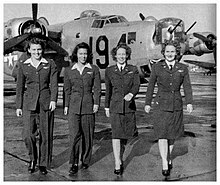
As the war progressed, the complexity of servicing the Liberator continued to increase. The B-24 variants made by each company differed slightly, so repair depots had to stock many different parts to support various models. Fortunately, this problem was eased in the summer of 1944, when North American, Douglas, and Consolidated Aircraft at Fort Worth stopped making B-24s, leaving only the Consolidated plant in San Diego and the Ford plant in Willow Run.[citation needed]
In all, 18,482 B-24s were built by September 1945. Twelve thousand saw service with the USAAF, with a peak inventory in September 1944 of 6,043. The U.S. Navy received 977 PB4Y-1s (Liberators originally ordered by the USAAF) and 739 PB4Y-2 Privateers, derived from the B-24. The Royal Air Force received about 2,100 B-24s equipping 46 bomber groups and 41 squadrons; the Royal Canadian Air Force (RCAF) 1,200 B-24Js; and the Royal Australian Air Force (RAAF) 287 B-24Js, B-24Ls, and B-24Ms. Liberators were the only heavy bomber flown by the RAAF in the Pacific. Two squadrons of the South African Air Force (SAAF) also flew B-24s: 31 and 34 Squadrons under No 2 Wing SAAF based at Foggia, Italy. These two squadrons engaged in relief flights to Warsaw and Kraków in Poland to support the Polish Uprising against Nazi Occupation.[20]
Strategic bombing
The B-24 was one of the workhorse bombers of the U.S. Eighth Air Force in the Combined Bomber Offensive against Germany, forming about one-third of its heavy bomber strength, with the other two-thirds being B-17s. Thousands of B-24s, flying from bases in England, dropped hundreds of thousands of tons of high explosive and incendiary bombs on German military and industrial targets. The 44th Bombardment Group was one of the first two heavy bombardment groups flying the B-24 with the 8th Air Force in the fall/winter air campaigns in the European Theater of Operations.[14] The 44th Bomb Group flew the first of its 344 combat missions against the Axis powers in World War II on 7 November 1942.[14]
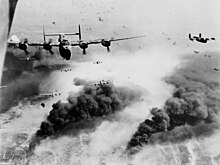
B-24s of the Ninth Air Force, operating from Africa and Italy, and the Fifteenth Air Force, also operating from Italy, took a major role in strategic bombing. Fifteen of the 15th AF's 21 bombardment groups flew B-24s. The Ninth Air Force moved to England in 1944 to become a tactical air force, and all of its B-24s were transferred to other Air Forces, such as the Fifteenth Air Force in Italy.
The first B-24 loss over German territory occurred on 26 February 1943. Earlier in the war, both the German Luftwaffe and the British Royal Air Force had abandoned daylight bombing raids because neither could sustain the losses suffered. The Americans persisted, however, at great cost in men and aircraft. In the period between 7 November 1942 and 8 March 1943, the 44th Bomb Group lost 13 of its original 27 B-24s.[14] For some time, newspapers had been requesting permission for a reporter to go on one of the missions. Robert B. Post and five other reporters of The New York Times were granted permission. Post was the only reporter assigned to a B-24-equipped group, the 44th Bomb Group. He flew in B-24 41-23777 ("Maisey") on Mission No. 37 to Bremen, Germany. Intercepted just short of the target, the B-24 came under attack from JG 1's Messerschmitt Bf 109s. Leutnant Heinz Knoke (who finished the war with 31 kills) shot down the Liberator. Post and all but two of the 11 men aboard were killed. Knoke reported:
The fire spread out along the right wing. The inboard propeller windmilled to a stop. And then, suddenly, the whole wing broke off. At an altitude of 900 metres there was a tremendous explosion. The bomber had disintegrated. The blazing wreckage landed just outside Bad Zwischenahn airfield.[21]

A total of 177 B-24s carried out the famous second attack on Ploești (Operation Tidal Wave) on 1 August 1943, flying from their bases in northwestern Libya. In late June 1943, the three B-24 Liberator groups of the 8th Air Force were sent to North Africa on temporary duty with the 9th Air Force.[14] The 44th Bomb Group was joined by the 93rd and the 389th Bomb Groups. These three units joined the two 9th Air Force B-24 Liberator groups for the 1 August 1943 low-level attack on the German-held Romanian oil complex at Ploești. This daring assault by high altitude bombers at tree top level was a costly success. The 44th destroyed both of its assigned targets, but lost 11 of its 37 bombers and their crews. Colonel Leon W. Johnson, the 44th's commander, was awarded the Medal of Honor for his leadership, as was Col. John Riley Kane, also known as "Killer" Kane, commander of the 98th Bomb Group. Kane and Johnson survived the mission but three other recipients of the Medal of Honor for their actions in the mission — Lt. Lloyd H. Hughes, Maj. John L. Jerstad and Col. Addison E. Baker — were killed in action. For its actions on the Ploești mission, the 44th was awarded its second Distinguished Unit Citation.[14] Of the 177 B-24s that were dispatched on this operation, 54 were lost.[14]
RAF Bomber Command did not use B-24s as bombers over Europe. No. 223 Squadron RAF, one of Bomber Command’s 100 (Bomber Support) Group squadrons, used 20 Liberator VIs to carry electronic jamming equipment to counter German radar. Liberators were also used as anti-submarine patrol aircraft by RAF Coastal Command.
Other roles
The B-24's long operating range made it suitable for other duties including maritime patrol, anti-submarine patrol, reconnaissance, tanker, cargo hauler, and personnel transport. Winston Churchill used a refurbished Liberator II as his personal transport aircraft.
Formation assembly
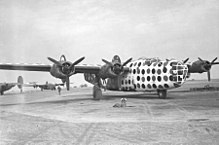
In February 1944, the 2nd Division authorized the use of war-weary aircraft specially fitted to aid assembly of individual group formations. Known as Assembly or Formation Ships, they were equipped with signal lighting, provision for quantity discharge of pyrotechnics, and featured distinctive individual paint schemes of psychedelic colors in stripes, checkers, or polka dots to enable easy recognition by their flock of bombers. The aircraft used in the first allocation were B-24Ds retired by the 44th, 93rd and 389th Groups. Arrangements for signal lighting varied from group to group, but generally consisted of white flashing lamps on both sides of the fuselage arranged to form the identification letter of the group. All armament and armor was removed, and in some cases the tail turret. In the B-24Hs used for this purpose, the nose turret was removed and replaced by a "carpetbagger" type nose. Following incidents when flare guns were accidentally discharged inside the rear fuselage, some Formation Ships had pyrotechnic guns fixed through the fuselage sides. As these aircraft normally returned to base once a formation had been established, a skeleton crew of two pilots, navigator, radio operator and one or two flare discharge men were carried. In some groups an observer officer flew in the tail position to monitor the formation. These aircraft became known as Judas Goats.[22]
Operation Carpetbagger
From August 1943 until the end of the war in Europe, specially modified B-24Ds were used in classified missions. In a joint venture between the Army Air Forces and the Office of Strategic Services (OSS) code named "Operation Carpetbagger", pilots and crews flew specially modified B-24Ds painted with a glossy black anti-searchlight paint to supply friendly underground forces throughout German occupied Europe. They also flew C-47s, A-26 Invaders, and British de Havilland Mosquitos. They flew spies called "Joes" and commando groups prior to the Allied invasion of Europe on D-Day and afterward, and retrieved over 5,000 officers and enlisted men who had escaped capture after being shot down. The low-altitude, night-time operation was extremely dangerous and took its toll on these airmen. The first aircrews chosen for this operation came from the anti-submarine bomb groups because of their special training in low altitude flying and pinpoint navigation skills. Also, because of their special skills, they were called upon to fly fuel to General George Patton's army when it outran its fuel supply. When this mission was completed, it was recorded that 822,791 gal (3,114,264 L) of 80 octane gasoline had been delivered to three different airfields in France and Belgium.[23]
Maritime patrol
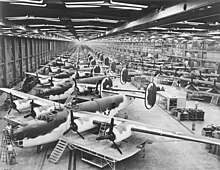
The Liberators made a great contribution to Allied victory in the Battle of the Atlantic against German U-boats. The decision to allocate some Liberator Is to Coastal Command in 1941 to patrol the eastern Atlantic Ocean produced immediate results. The Very Long Range (VLR) Liberators "almost doubled the reach of Britain's maritime reconnaissance force".[24] This extended range enabled Coastal Command patrols to cover part of the mid-Atlantic gap, where U-boats had operated without risking being attacked and sunk by Allied aircraft.[25]
For 12 months, No. 120 Squadron RAF of Coastal Command with its handful of much-patched and modified early model Liberators, supplied the only air cover for convoys in the Atlantic Gap, the Liberator being the only warplane with sufficient range. The VLR Liberators sacrificed some armor and often gun turrets in order to save weight, while carrying extra aviation gasoline in their bomb-bay tanks. Liberator Is were equipped with ASV (Air to Surface Vessel) Mark II radar, which together with the Leigh light gave them the ability to hunt U-boats by day and by night.
These Liberators operated from both sides of the Atlantic with the Royal Canadian Air Force and the U.S. Navy from the west; and with the RAF from the east, based in Northern Ireland, Scotland, Iceland, and beginning in mid-1943 from the Azores. This role was dangerous, especially after many U-boats were armed with extra anti-aircraft guns, some adopting the policy of staying on the surface to fight, rather than submerging and risking being sunk by ASW (anti-submarine warfare) torpedoes and depth charges from the bombers. In addition to flying from the East Coast of the United States, American Liberators flew from Greenland, the Azores, Bermuda, the Bahamas, Puerto Rico, Cuba, Trinidad, and from wherever else they could fly far out over the Atlantic.
The rather sudden and decisive turning of the Battle of the Atlantic in favor of the Allies in May 1943 was the result of many factors. However, it was no accident that it coincided with the long delayed arrival of many more VLR Liberators for maritime patrols. Liberators were credited in full or in part with 72 U-boat sinkings.
In addition to very long range patrols, the B-24 was vital for patrols of a radius less than 1,000 mi (1,600 km), in both the Atlantic and Pacific theaters where U.S. Navy Privateers and USAAF B-24s took a heavy toll of German and Japanese submarines, and also some Japanese surface shipping.
The Consolidated Aircraft Company PB4Y Privateer was a World War II U.S. Navy patrol bomber that was derived directly from the B-24 Liberator. The U.S. Navy had been using unmodified B-24s as the PB4Y-1 Liberator, and this type of patrol plane was considered to be quite successful. However, a fully navalized design was advantageous, and Consolidated Aircraft developed a purpose-built long-range patrol bomber in 1943, designated PB4Y-2 Privateer, that was visually distinguishable from the B-24 and PB4Y-1 by having a single vertical stabilizer rather than a twin tail.
Air transports
Early model Liberators were used as unarmed long-range cargo carriers. They flew between Britain and Egypt (with an extensive detour around Spain over the Atlantic), and they were used in the evacuation of Java in the East Indies. Liberator IIs were converted for this role and were used by the British Overseas Airways Corporation (BOAC) for trans-Atlantic services and other various long-range air transportation routes. This version of the Liberator was designated the LB-30A by the USAAF.[13]
By early 1943, the need for a transport with better high altitude performance and longer range than the Douglas C-47 Skytrain had become pressing. A transport version of the B-24 was proposed, and soon afterward, a B-24D that had been damaged in an accident was converted into a cargo aircraft by elimination of its transparent nose and the installation of a flat cargo floor.
C-87 version
In April 1943, the C-87 Liberator Express transport entered production at Fort Worth, Texas. The C-87 had a large cargo door, less powerful supercharged engines, no gun turrets, a floor in the bomb bay for freight, and some side windows. The navigator's position was relocated behind the pilot. Early versions were fitted with a single .50 caliber (12.7 mm) Browning machine gun in their tails, and a few C-87s were also equipped with two .50 caliber (12.7 mm) fixed machine guns in their noses, operable by the pilot, though these were eventually removed. A more dedicated VIP transport, the C-87A, was also built in small numbers.
The C-87 was also designated the RY-2 or Liberator Cargo VII. Although only 287 C-87 and RY variants were produced, they were still important in the Army Air Forces' airlift operations early in the war when aircraft with high altitude, long-range heavy hauling abilities were in short supply. The C-87 flew in many theaters of war, including much hazardous duty in flights from Labrador to Greenland and Iceland in the North Atlantic. In the China Burma India Theater (CBI), the C-87 was used to airlift cargo and fuel over the Hump (the Himalayas) from India to China. Early in the campaign, the C-87 was the only readily available American transport that could fly over the Himalayas while heavily loaded, rather than relying on circuitous and highly dangerous routes through valleys and mountain passes.
The C-87 was not very popular with the aircrews assigned to fly it. The aircraft had the distressing habit of losing all cockpit electrical power on takeoff or at landings, while its engine power and reliability with the less-powerful superchargers often left much to be desired. It proved to be quite vulnerable to icing conditions, and was prone to fall into a spin with even small amounts of ice accumulated onto its Davis wing. Since the aircraft had been designed to be a bomber that dropped its loads while airborne, the C-87's nose landing gear was not designed for landing with a heavy load, and frequently it collapsed from the stress. Fuel leaks inside the crew compartment from the hastily modified long-range fuel system were an all-too-common occurrence. Lastly, unlike a typical purpose-designed transport, the B-24 was not designed to tolerate large loading variations because most of its load was held on fixed bomb racks. Consequently, it was far too easy for a poorly trained ground crew to load a C-87 with its center of gravity too far forward or aft, rendering the aircraft too longitudinally stable or unstable and difficult to control. In his autobiography, Fate is the Hunter, the writer Ernest K. Gann reported that, while flying air cargo in India, he barely avoided crashing an improperly loaded C-87 into the Taj Mahal. As soon as more dependable Douglas C-54 Skymaster and Curtiss-Wright C-46 Commando transports became available in large numbers, C-87s were rapidly phased out of combat zone service, with some later used as VIP transports or B-24 flight crew trainers.
C-109 version
The C-109 was a dedicated fuel transport version of the B-24 conceived as a support aircraft for B-29 Superfortress operations in central China. Unlike the C-87, the C-109 was not built on the assembly line, but rather was converted from existing B-24 bomber production; to save weight, the glass nose, armament, turret fairings and bombardment equipment were removed. Several storage tanks were added, allowing a C-109 to carry almost 2,905 gal (11,000 L) of fuel weighing over 22,000 lb (10,000 kg).
Plans originally called for 2,000 C-109s to support 10 groups of B-29s (approximately 400) in China, but the capture of the Mariana Islands provided a far more easily resupplied location for raids on mainland Japan, and the plans were greatly scaled back. Only 218 C-109s were actually converted. After the transfer of the B-29s, the C-109s were reassigned to the Air Transport Command. According the history of the U.S. Army Air Forces in World War II, at least one squadron was assigned to the IX Troop Carrier Command in Europe to transport gasoline to advancing ground and air forces on the Continent after the Normandy invasion.
However, whereas a combat-loaded B-24 could safely take off with room to spare from a 6,000 ft (1,800 m) runway, a loaded C-109 required every foot of such a runway to break ground, and crashes on takeoff were not uncommon. The aircraft demonstrated unstable flight characteristics with all storage tanks filled, and proved very difficult to land fully loaded at airfields above 6,000 ft (1,830 m) MSL in elevation, such as those around Chengdu. After it was discovered that these problems could be alleviated by flying with the forward storage tank empty, this practice became fairly routine, enhancing aircrew safety at the cost of some fuel-carrying capacity.[26] Many C-109s were lost in flying the Hump airlift to China.
B-24 bombers were also extensively used in the Pacific area after the end of World War II to transport cargo and supplies during the rebuilding of Japan, China, and the Philippines.
Australian use
In June 1944, Qantas Empire Airways began service with the first of two converted Liberators on the Perth to Colombo route to augment Consolidated PBY Catalinas that had been used since May 1943. This route across the Indian Ocean was 3,513 mi (5,654 km) long, the longest non-stop airline route in the world at the time. The Liberators flew a shorter 3,077 mi (4,952 km) over-water route from Learmonth to an airfield northeast of Colombo, but they could make the flight in 17 hours with a 5,500 lb (2,495 kg) payload, whereas the Catalinas required 27 hours and had to carry so much auxiliary fuel that their payload was limited to only 1,000 lb (454 kg). The route was named Kangaroo Service and marked the first time that Qantas' now-famous Kangaroo logo was used; passengers received a certificate proclaiming them as members of The Order of the Longest Hop. The Liberators were later replaced by Avro Lancastrians.[27]
Luftwaffe use
The B-24 was operated by the German secret operations unit KG 200, which also tested, evaluated and sometimes clandestinely operated captured enemy aircraft during World War II.[28]
Soviet use
Only one B-24 was officially delivered to the USSR according to the Lend-Lease agreements, stranded in Yakutsk while flying a government mission to the Soviet Union in November 1942. In addition, 73 Liberators of various models that had force-landed in Europe airfields were recovered and 30 of them were repaired and used by the 45th BAD.[29]
Variants and conversions
U.S. Army Air Forces variants
- XB-24 ( Model 32)
- Designed in 1938 as an improvement on the B-17 Flying Fortress, at the request of the Army Air Corps. It had a wing specially designed for a high aspect ratio, tricycle landing gear, and twin vertical stabilizers. The XB-24 was ordered in March 1939 and first flew on 29 December 1939. (Total: one)
- YB-24/LB-30A Pre-production prototypes
- Six examples were sent to Great Britain under Lend-Lease, designated LB-30A.
- B-24
- Service test version of the XB-24, ordered on 27 April 1939, less than 30 days after the XB-24 was ordered and before its completion. A number of minor modifications were made: elimination of leading edge slots, addition of de-icing boots. (Total: seven; only one used for actual testing)
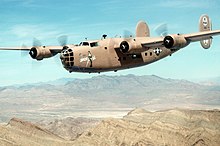
- B-24A/LB-30B
- Ordered in 1939, the B-24A was the first production model. Due to the need for heavy bombers, the B-24A was ordered before any version of the B-24 flew. The main improvement over the XB-24 was improved aerodynamics, which led to better performance. Some sent to Great Britain under Lend-Lease as LB-30B. (Total: 20 LB-30B; 1 B-24A)
- XB-24B
- When the XB-24 failed to reach its projected top speed, the Pratt & Whitney R-1830-33 radials rated at 1,000 hp (746 kW) it carried were replaced with R-1830-41 turbo-supercharged radials rated at 1,200 hp (895 kW), increasing its top speed by 37 mph (59 km/h). The engine cowlings were made elliptical to accommodate the addition of the turbo-superchargers. The XB-24B version also lacked the engine slots of the original. (Total: one converted XB-24)
- B-24C
- Conversion of the B-24A using turbo-supercharged R-1830-41 engines. To hold the supercharger and the intercooler intake, the cowlings were made elliptical and the new items added on the sides. The tail air gunner position was improved by adding a hydraulically powered Consolidated A-6 turret with twin .50 caliber (12.7 mm) machine guns; a Martin power turret was added to the forward fuselage. (Total: nine converted B-24As)

- B-24D
- First model produced on a large scale; ordered from 1940 to 1942, as a B-24C with better engines (R-1830-43 supercharged engines). The D model was initially equipped with a remotely operated and periscopically sighted Bendix belly turret, as the first examples of the B-17E Flying Fortress had used, but this proved unsatisfactory in service and was discontinued after the 287th aircraft. Production aircraft reverted to the earlier manually operated "tunnel" mounting with a single .50 caliber (12.7 mm) machine. The tunnel gun was eventually replaced by the retractable Sperry ball turret, which had also been adopted by the later B-17E Fortresses. In late B-24Ds, "cheek" guns were added. (Total: 2,696: 2,381 Consolidated, San Diego; 305 Consolidated, Fort Worth; 10 Douglas, Tulsa, Oklahoma).
- B-24E
- A slight alteration of the B-24D built by Ford, using R-1830-65 engines. Unlike the B-24D, the B-24E retained the tunnel gun in the belly. The USAAF used the B-24Es primarily as training aircraft since this model was not current in armaments and other technology as were the aircraft being produced by Consolidated / San Diego (CO). Ford also built sub-assemblies for Douglas; these sub-assemblies were identical to Ford-built B-24Es, except that they used the same engines as the B-24D (R-1830-43 radials). These sub-assemblies were called PK ships and were shipped by truck from Willow Run to the final assembly in Tulsa, Oklahoma. (Total: 801)
- XB-24F
- A prototype made to test thermal de-icers instead of the standard inflatable rubber "boots". (Total: one converted B-24D)
- B-24G
- Designation for B-24D aircraft built by North American Aviation pursuant to a 1942 contract. Equipped with Sperry ball turret and three .50 caliber (12.7 mm) machine guns in nose. (Total: 25)
- B-24G-1
- Designation for North American-built version of the B-24H. Most B-24G aircraft were delivered to the 15th Air Force in Italy. (Total: 405)
- B-24H
- Because of obvious vulnerability of the B-24 to head-on attack, the B-24H design incorporated an electrically powered Emerson A-15 nose turret. Approximately 50 other airframe changes were made, including a redesigned bombardier compartment. The tail turret was given larger windows for better visibility and the Martin A-3 top turret received an enlarged "high hat" dome. The waist gunner positions were enclosed with Plexiglas windows and offset to reduce mutual interference between the gunners during battle. Most H model aircraft were built by Ford at the Willow Run factory. (Total: 3,100)

- B-24J
- The B-24J was very similar to the B-24H, but shortages of the Emerson nose turret required use of a modified, hydraulically powered Consolidated A-6 turret in most J model aircraft built at Consolidated's San Diego and Fort Worth factories. The B-24J featured an improved autopilot (type C-1) and a bombsight of the M-1 series. B-24H sub-assemblies made by Ford and constructed by other companies and any model with a C-1 or M-1 retrofit, were all designated B-24J. The J model was the only version to be built by all five factories involved in B-24 production. (Total: 6,678)
- XB-24K
- An experimental aircraft, made by Ford by splicing a B-23 Dragon tail empennage onto a B-24D airframe. The aircraft was more stable and had better handling than other models, leading to the decision to incorporate a single tail in the PB4Y-2 and B-24N. (Total: one converted B-24D)
- B-24L
- Because of the excessively high gross weight of the B-24J, the Army pushed for a lighter version. In the B-24L, the Sperry ball turret was replaced by a floor ring mount with two .50 caliber (12.7 mm) machine guns, and the A-6B tail turret by an M-6A. Later aircraft were delivered from the factory without tail armament. An A-6B, M-6A, or a manually operated twin .50 caliber (12.7 mm) mounting was then installed at a depot before arrival at operational units. The L model was built only at Willow Run and Consolidated's San Diego factory. (Total: 1,667)

- B-24M
- An enhancement of the B-24L with further weight-saving devices. The B-24M used a more lightweight version of the A-6B tail turret; the waist gunner positions were left open. For better visibility from the flight deck, the windshield in Ford-built aircraft was replaced by a version with less framing from Block 20 onward. The B-24M became the last production model of the B-24; a number of the B-24s built flew only the course between the factory and the scrapheap. (Total: 2,593)
- XB-24N
- A redesign of the B-24J, made to accommodate a single tail. It also featured an Emerson 128 ball turret in the nose and a stationary tail gunner's position. While 5,168 B-24Ns were ordered, the end of the war resulted in cancellation of all contracts before production could begin. (Total: one)
- YB-24N
- Pre-production service test version of the XB-24N. (Total: seven)
- XB-24P
- A modified B-24D, used by Sperry Gyroscope Company to test airborne fire control systems. (Total: one converted B-24D)
- XB-24Q
- A General Electric conversion of the B-24L. Used to test a radar-controlled tail turret intended for use in the Boeing B-47 Stratojet. (Total: one converted B-24L)
- XB-41
- Because there were no fighters capable of escorting bomber formations on deep strike missions early in World War II, the Army authorized tests for heavily armed bombers to act as escorts for bombing missions. The XB-41 had fourteen .50 caliber (12.7 mm) machine guns, including a Bendix chin turret and a second Martin A-3 turret on the upper fuselage. A single aircraft was completed in 1942. Performance changed drastically with the addition of more turrets. The escorts were also unable to keep up with bomber formations once the bombs had been dropped. The results of 1943 testing were very negative and the project was quickly canceled. (Total: one converted B-24D)
- AT-22 or TB-24
- C-87 used for flight engineer training.
- RB-24L: Developed for training B-29 gunners on an identical remote gun system installed on a B-24L.
- TB-24L: As with the RB-24L, but with additional radar equipment.

- C-87 Liberator Express
- Passenger transports with accommodation for 20 passengers.
- C-87A: VIP transports with R-1830-45 instead of -43 engines and sleep accommodations for 16 passengers.
- C-87B: Projected armed transport variant with nose guns, dorsal turret, and ventral tunnel gun; never produced.
- C-87C: U.S. Army Air Force/Air Force designation for the RY-3.
- XC-109/C-109
- Tankers with specialized equipment to help prevent explosions, used to ferry fuel from India to China to support initial B-29 raids against Japan.
- XF-7
- Photographic reconnaissance variant developed from the B-24D.
- F-7
- Photographic reconnaissance variant developed from the B-24H; -FO block.
- F-7A
- Photographic reconnaissance variant developed from the B-24J; three cameras in the nose and three in the bomb bay.
- F-7B
- Photographic reconnaissance variant developed from the B-24J; six cameras in the bomb bay.
- BQ-8
- A number of worn-out B-24D and B-24Js were converted as radio-controlled flying bombs to attack German targets. Joseph P. Kennedy, Jr. was killed in a BQ-8 during Operation Aphrodite.[31]
U.S. Navy nomenclature and sub-variants
- PB4Y-1
- U.S. Navy designation applied to 976 navalized B-24D, J, L and M models built at Consolidated's San Diego factory, as well as one North American-built B-24G. Later aircraft were equipped with an ERCO bow turret.[32]
- PB4Y-1P
- Photographic reconnaissance variant developed from the PB4Y-1.
- PB4Y-2 Privateer
- See Main Article
- P5Y
- Proposed twin-engined patrol version of PB4Y-1. Unbuilt.[33]
- RY-1
- U.S. Navy designation for the C-87A.
- RY-2
- U.S. Navy designation for the C-87.
- RY-3
- Transport variant of the PB4Y-2.
British nomenclature and sub-variants
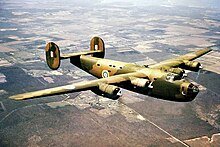
- Liberator B Mk I
- B-24A, direct purchase aircraft for the RAF. (Total: 20) Considered unsuitable for combat, some rebuilt as the GR.1 and used in British anti-submarine patrol squadrons.
- Liberator B Mk II
- The first combat-ready B-24. The modifications included a three-foot nose extension as well as a deeper aft fuselage and wider tailplane — there was no direct B-24 equivalent but similar to the B-24C, built to meet British specifications with British equipment and armament. A small series of B Mk IIs were reconstructed as unarmed transports, designated the LB-30 with the USAAF. (Total production: 165)
- Liberator B Mk III
- B-24D variant with single .303 in (7.7 mm) Browning machine gun in the nose, two in each beam position, and four in a Boulton Paul tail turret — similar to that on contemporary British heavy bombers such as the Halifax — as well as other British equipment. The Martin dorsal turret was retained. (Total: 156)
- Liberator B Mk IIIA: Lend-Lease B-24Ds with American equipment and weapons.
- Liberator B Mk IV
- Reserved for the B-24E, but there is no record of the RAF actually receiving any.
- Liberator B Mk V
- B-24D modified for extra fuel capacity at the cost or armor, with the same armament fit as the Liberator Mk III.
- Liberator B Mk VI
- B-24Hs in RAF service fitted with Boulton Paul tail turrets, but retaining the rest of their armament.
- Liberator B Mk VIII
- RAF designation for B-24Js.

- Liberator GR Mk V
- B-24D modified by RAF Coastal Command for the anti-submarine role with search radar and Leigh Light. Some were fitted with eight zero-length rocket launchers, four on each wing.
- Liberator GR Mk VI
- B-24G/H/J type used as a long-range general reconnaissance aircraft by RAF Coastal Command.
- Liberator GR Mk VIII
- B-24J modified by RAF Coastal Command for the anti-submarine role.
- Liberator C Mk VI
- Liberator B Mk VIII converted for use as a transport.
- Liberator C Mk VII
- British designation for C-87.
- Liberator C Mk VIII
- Liberator G Mk VIII converted for use as a transport.
- Liberator C Mk IX
- RAF designation for the RY-3/C-87C
Late in the war RAF Liberator aircraft modified in England for use in South East Asia had the suffix "Snake" stenciled below the serial number to give them priority delivery through the Mediterranean and Middle East.[34]
Operators
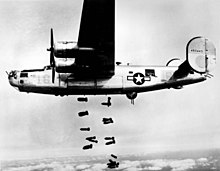
 Australia
Australia Brazil
Brazil Canada
Canada Republic of China
Republic of China Czechoslovakia
Czechoslovakia Germany (as Beuteflugzeug, captured aircraft)
Germany (as Beuteflugzeug, captured aircraft) India A total of 42 B-24s recovered from aircraft dumps and restored by HAL were operational with No.5, No.6 and N.16 Squadrons.[35]
India A total of 42 B-24s recovered from aircraft dumps and restored by HAL were operational with No.5, No.6 and N.16 Squadrons.[35] Italy
Italy Netherlands
Netherlands Nicaragua CIA delivered two B-24Hs in the 1950s[citation needed]
Nicaragua CIA delivered two B-24Hs in the 1950s[citation needed] Romania At least three B-24Ds and one B-24J were rebuild from wrecks around Ploiești in 1943–44.[36]
Romania At least three B-24Ds and one B-24J were rebuild from wrecks around Ploiești in 1943–44.[36] Poland
Poland Portugal
Portugal Soviet Union
Soviet Union South Africa
South Africa Turkey
Turkey United Kingdom
United Kingdom United States
United States
Survivors
Specifications (B-24J)

Data from Quest for Performance[37]
General characteristics
- Crew: 7-10Zero-lift drag coefficient: 0.0406
- Drag area: 42.54 ft² (3.95 m²)
- Aspect ratio: 11.55
Performance
- Lift-to-drag ratio: 12.9
Armament
- Guns: 10 × .50 caliber (12.7 mm) M2 Browning machine guns in 4 turrets and two waist positions
- Bombs:
- Short range (˜400 mi): 8,000 lb (3,600 kg)
- Long range (˜800 mi): 5,000 lb (2,300 kg)
- Very long range (˜1,200 mi): 2,700 lb (1,200 kg)
Notable B-24 crew
- Don Herbert, television pioneer "Mr. Wizard", flew 56 missions as a Liberator pilot over Northern Italy, Germany, and Yugoslavia, winning the Distinguished Flying Cross.
- American Senator and 1972 presidential candidate George McGovern served as a B-24 pilot in missions over Italy as a member of the 455th Bomb Group of the Fifteenth Air Force; his wartime exploits and some of the characteristics of the B-24 are the focus of Stephen Ambrose's book The Wild Blue.
- Brigadier General Jimmy Stewart USAF Reserve, flew B-24s as commanding officer of the 703rd BS, 445th BG out of RAF Tibenham, UK, before a promotion to operations officer of the 453rd BG. From 1943 to 1944, Stewart was credited with 20 combat missions as a pilot, including one over Berlin. Stewart flew several more (possibly as high as 20 additional) uncredited missions, filling in for pilots as duties and space would allow. Stewart's leadership qualities were highly regarded; the men who served under him praised his coolness under fire. He entered service as a private in early 1941 and rose to the rank of colonel by 1945.
- Former Speaker of the House, Jim Wright, served as a B-24 bombardier in the Pacific. He recounts his experience in his book The Flying Circus: Pacific War — 1943 — as Seen Through a Bombsight.
- William Charles Anderson, author of BAT-21 and Bomber Crew 369, piloted Liberators based in Italy as a member of the 451st Bomb Group of the 15th AF.
- B-24J Lonesome Lady, 494th Bomb Group, 7th Air Force, piloted by Lt. Thomas Cartwright, was shot down 28 July 1945 over Kure, Japan. Eight crew members survived; Lt. Cartwright was taken to Tokyo for questioning, and the remaining seven were taken to the military police facility in Hiroshima, fifteen miles away. They died there nine days later, 6 August 1945, when the atomic bomb was dropped on the city.
- Film director Robert Altman was a B-24 co-pilot flying over 50 bombing missions in Borneo and the Dutch East Indies.
- Stewart Udall, author, conservationst, Arizona Congressman, and Secretary of Interior during the Kennedy and Johnson administrations, served as a waist gunner on a B-24 in 1944. He was based in Southern Italy; 15th Army AF, 454th Bombardment Group. His Liberator's nickname was "Flyin' Home." He is credited with 50 missions. The 454th received a Unit Citation for leading an attack on the Hermann Goering Steel Works in Linz, Austria on 25 July 1944. Udall's crew suffered one casualty on the mission. The dead crew member was serving at the waist-gunner position normally manned by Udall; by chance, the Pilot assigned Udall to the nose gun for this mission, saving his life.
- Olympic runner, and later war prisoner and hero Louis Zamperini, served as a bombardier on two B-24s. The first, which the crew named "Super Man" was damaged and they were assigned the B-24D "Green Hornet" to conduct search and rescue. On May 27 1943, the aircraft crashed into the Pacific Ocean. Eight of the 11 crewmembers were killed except Zamperini, the pilot, Russell A. Phillips, and Francis McNamara, who managed to survive the crash and escape on a life raft. Only Zamperini and Phillips survived their 47 days adrift on the sea.[38]
- Russell Johnson, the actor who played The Professor on Gilligan's Island, earned the Purple Heart when his B-24 Liberator was shot down in the Philippines during a bombing run in March 1945.
- William Fili author of Passage to Valhalla. Robert Culver "Pop" in the book earned a Purple Heart.
Notable appearances in media
- The book One Damned Island After Another (1946) contains the official history of the 7th Bomber Command of the Seventh Air Force. It describes B-24 operations in the Central Pacific. B-24s from the Seventh Air Force were the first B-24s to bomb the Japanese home islands.
- The story of the "Lady Be Good" inspired a television movie titled The Sole Survivor (1970 film), with a North American B-25 Mitchell playing the B-24D role.
- In the young adult novel Under a War-Torn Sky, the main character Henry Forester co-pilots Out of the Blue, a U.S. B-24 Liberator serving in the Royal Air Force.
- In the video game Call of Duty: Big Red One, one of the levels includes using the various turrets and the bomb-sight in a B-24 Liberator.
- The B-24 is featured in the classic novel Goodbye to Some by Gordon Forbes, a former pilot, who seems to know the foibles of the aircraft. Of special note is the characteristic "siphoning" during flight of fuel from the tanks in the wings, caused by a venturi effect of air passing over the wings, sometimes resulting in a mid-air explosion of the aircraft.[39]
See also

Related development
- Consolidated B-32 Dominator
- Consolidated C-87 Liberator Express
- PB4Y Privateer
- Consolidated XB-41 Liberator
- Consolidated XB-24
- Consolidated Liberator I
- Consolidated R2Y
Aircraft of comparable role, configuration, and era
- Avro Lancaster
- B-17 Flying Fortress
- Focke-Wulf Fw 200
- Handley-Page Halifax
- Junkers Ju 290
- Petlyakov Pe-8
- Piaggio P.108B
- Short Stirling
- Vickers Warwick
Related lists
- List of aircraft of World War II
- List of bomber aircraft
- List of military aircraft of the United States
References
- Notes
- Citations
- ^ Bhargava, Kapil, Group Captain (ret'd). "Indian's Reclaimed B-24 Bombers." bharat-rakshak.com. Retrieved: 16 June 2010.
- ^ a b Nolan, Jenny. "Michigan History: Willow Run and the Arsenal of Democracy." The Detroit News, 28 January 1997. Retrieved: 7 August 2010.
- ^ Ethell 1995, p. 214.
- ^ Birdsall 1968, p. 3.
- ^ Winchester 2004, p. 56.
- ^ a b Ethell 1995, p. 215.
- ^ Taylor 1969, p. 462.
- ^ Vincenti, Walter G. "The Davis Wing and the Problem of Aerofoil Design: Uncertainty and Growth in Engineering Knowledge". Technology and Culture, Vol. 27, No. 4, October 1986.
- ^ Baugher, Joe. "The Consolidated XB-24." USAAC/USAAF/USAF Bombers: The Consolidated B-24 Liberator, 8 August 1999. Retrieved: 15 June 2010.
- ^ Cravens and Cate. US Army Air Forces in World War II. Office of Air Force History.
- ^ Donald 1997, p. 266.
- ^ Birdsall 1968, p. 40.
- ^ a b Taylor 1968, p. 463.
- ^ a b c d e f g Allan, Chuck. "A Brief History of the 44th Bomb Group." chuckallan.com. Retrieved: 15 June 2010.
- ^ Hillenbrand 2010 [page needed]
- ^ Green 195, p. 84.
- ^ March 1998, p. 63.
- ^ Birdsall 1975, p. 5.
- ^ Lord 1967, p. 279.
- ^ Isemonger, L.
- ^ Weal 2006, p. 16.
- ^ Freeman 1984, p. 176.
- ^ Parnell 1993, pp. inside cover, p. 91.
- ^ Green 1975, p. 85.
- ^ Winchester 2004, p. 57.
- ^ Baugher, Joe. "Consolidated C-109". USAAC/USAAF/USAF Bombers: The Consolidated B-24 Liberator, 16 August 1999. Retrieved: 15 June 2010.
- ^ "Indian Ocean – New Guinea – Kangaroo Service – 1950–1946." Flight Global website, 16 November 1950. Retrieved: 29 August 2009.
- ^ Gilman and Clive 1978, p. 314.
- ^ Gordon 2008, p. 479.
- ^ "Ol 927: CAF's B-24A Liberator." Warbird Digest, Issue 15, July–August 2007, pp. 17–30.
- ^ Andrade 1979, p. 60.
- ^ Baugher, Joe. "Consolidated PB4Y-1." USAAC/USAAF/USAF Bombers: The Consolidated B-24 Liberator, 18 August 1999. Retrieved: 15 June 2010.
- ^ Wegg 1990, p. 90.
- ^ Robertson 1998
- ^ "Liberator." bharat-rakshak.com. Retrieved: 9 December 2010.
- ^ Axworthy, p. 281
- ^ Loftin, L.K. Jr. "Quest for Performance: The Evolution of Modern Aircraft." NASA SP-468. Retrieved: 22 April 2006.
- ^ Hillenbrand 2010[page needed]
- ^ "Reviews: 'Goodbye to Some'." amazon.com. Retrieved: 27 March 2010.
- Bibliography
- Axworthy, Mark. Third Axis Fourth Ally: Romanian Armed Forces in the European War, 1941-1945. London: Arms & Armour, First Edition edition 1995. ISBN 978-1854092670.
- Andrade, John. U.S. Military Aircraft Designations and Serials since 1909. Hinckley, Leicestershire, UK: Midland Counties Publications, 1979. ISBN 0-904597-22-9.
- Birdsall, Steve. The B-24 Liberator. New York: Arco Publishing Company, Inc., 1968. ISBN 0-668-01695-7.
- Birdsall, Steve. B-24 Liberator In Action (Aircraft number 21). Carrollton, Texas: Squadron/Signal Publications, Inc., 1975. ISBN 0-89747-020-6.
- Birdsall, Steve. Log of the Liberators. New York: Doubleday, 1973. ISBN 0-385-03870-4.
- Blue, Allan G. The B-24 Liberator, A Pictorial History. Shepperton, Surrey, UK: Ian Allan Ltd., 1976. ISBN 0-7110-0630-X.
- Bowman, Martin. Combat Legend: B-24 Liberator. Shrewsbury, UK: Airlife Publishing Ltd, 2003. ISBN 1-84037-403-9.
- Bowman, Martin. The B-24 Liberator 1939–1945. Norwich, Norfolk, UK: Wensum Books Ltd, 1979. ISBN 0-903619-27-X.
- Currier, Donald R. Lt. Col. (Ret). 50 Mission Crush. Shippensburg, Pennsylvania: Burd Street Press, 1992. ISBN 0-942597-43-5.
- Davis, Larry. B-24 Liberator in Action (Aircraft number 80). Carrollton, Texas: Squadron/Signal Publications, Inc., 1987. ISBN 0-89747-190-3.
- Donald, David, general editor. Encyclopedia of World Aircraft. Etobicoke, Ontario: Prospero Books, 1997. ISBN 1-85605-375-X.
- Ethell, L. Jeffrey. Aircraft of World War II. Glasgow: HarperCollins Publishers, 1995. ISBN 0-00-470849-0.
- Freeman, Roger. B-24 at War. Shepperton, Surrey, UK: Ian Allan Ltd., 1983. ISBN 0-7110-1264-4.
- Freeman, Roger. Mighty Eighth War Manual. London: Jane's Publishing Company Limited, 1984. ISBN 0-71060-325-8.
- Gann, Ernest K. Fate Is The Hunter. New York: Simon & Shuster, 1986. ISBN 0-671-63603-0.
- Gilman J.D. and J. Clive. KG 200. London: Pan Books Ltd., 1978. ISBN 0-85177-819-4.
- Gordon, Yefim. Soviet Air Power in World War 2. Hinckley, Lancashire, UK: Midland, Ian Allan Publishing, 2008. ISBN 978-185780-304-4.
- Green, William. Famous Bombers of the Second World War. New York: Doubleday & Company, 1975. ISBN 0-385-12467-8.
- Hillenbrand, Laura. Unbroken: A World War II Story of Survival, Resilience, and Redemption. New York: Random House, 2010. ISBN 978-1-4000-6416-8.
- Isemongers, Lawrence, The Men Who Went to Warsaw, Nelspruit: Freeworld Publications, 2002, ISBN 0958438846.
- Job, Macarthur. "Misadventure at Mauritius." Flight Safety Magazine, January–February 2000.
- Johnsen, Frederick A. Consolidated B-24 Liberator (WarbirdTech Volume 1). North Branch, Minnesota: Specialty Press, 2001. ISBN 1-58007-054-X.
- Johnsen, Frederick A. B-24 Liberator: Combat and Development History of the Liberator and Privateer. St. Paul, Minnesota: Motorbooks International, 1993. ISBN 0-87938-758-0.
- Johnsen, Frederick A. Bombers in Blue: PB4Y-2 Privateers and PB4Y-1 Liberators. Tacoma, Washington: Bomber Books, 1979. No ISBN.
- Lord, Walter. Incredible Victory. New York: Harper & Row, 1967. ISBN 1-58080-059-9.
- March, Daniel J., ed. British Warplanes of World War II. London: Aerospace Publishing, 1998. ISBN 1-874023-92-1.
- McDowell, Ernest and Richard Ward. Consolidated B-24D-M Liberator in USAAF-RAF-RAAF-MLD-IAF-CzechAF & CNAF Service, PB4Y-1/2 Privateer in USN-USMC-Aeronavale & CNAF Service. New York: Arco Publishing Company, Inc., 1969. ISBN 0-668-02115-2.
- Moyes, Philip J.R. Consolidated B-24 Liberator (Early Models). Kidlington, Oxford, UK: Vintage Aviation Publications Ltd., 1979. ISBN 0-905469-70-4.
- North, Tony and Mike Bailey. Liberator Album, B-24's of the 2nd Air Division 8th Air Force. Volume 1: The 20th. Combat Bomb Wing. Norwich, Norfolk, UK: Tony North, 1979. No ISBN.
- North, Tony and Mike Bailey. Liberator Album, B-24's of the 2nd Air Division 8th Air Force. Volume 2: The 14th. Combat Bomb Wing. Norwich, Norfolk, UK: Tony North, 1981. No ISBN.
- O'Leary, Michael. Consolidated B-24 Liberator. Botley, UK: Osprey Publishing, 2002. ISBN 1-84176-023-4.
- Parnell, Ben. Carpetbaggers America's Secret War in Europe. Austin, Texas: Eakin Press, 1987, revised edition 1993. ISBN 978-0890155929.
- Robertson, Bruce. British Military Aircraft Serials: 1878–1987. Hinckley, Leicestershire, UK: Midland Counties Publications, 1998. ISBN 978-0904597615.
- Scearce, Phil. Finish Forty and Home: The Untold World War II Story of B-24s in the Pacific. Denton, Texas: University of North Texas Press, 2011. ISBN 978-1-57441-316-8.
- Shacklady, Edward. Classic WWII Aviation: Consolidated B-24. Bristol, UK: Cerberus Publishing Ltd., 2002. ISBN 1-84145-106-1.
- Taylor, John W. R. "Consolidated B-24/PB4 Y Liberator." Combat Aircraft of the World from 1909 to the present. New York: G.P. Putnam's Sons, 1969. ISBN 0-425-03633-2.
- Wagner, Ray. American Combat Planes. New York: Doubleday & Company, Inc., 1968. ISBN 0-385-04134-9.
- Ward, Richard and Eric A. Munday. USAAF Heavy Bomb Group Markings & Camouflage 1941–1945, Consolidated Liberator. Reading, Berkshire, UK: Osprey Publishing Ltd., 1972. ISBN 0-85045-128-0.
- Weal, John. Bf 109 Defence of the Reich Aces. Oxford, UK: Osprey, 2006. ISBN 1-84176-879-0.
- Wegg, John. General Dynamic Aircraft and their Predecessors. London: Putnam, 1990. ISBN 0-85177-833-X.
- Winchester, Jim. "Consolidated B-24 Liberator." Aircraft of World War II: The Aviation Factfile. Kent, UK: Grange Books plc, 2004. ISBN 1-84013-639-1.
External links
- (1942) Flight Manual B-24D Airplane
- Consolidated B-24A page
- Consolidated B-24D page, USAF National Museum
- WWII photos of the 7th AAF Heavy Bombardment Group Liberators
- SP-468 Quest for Performance: The Evolution of Modern Aircraft, NASA
- Warbirds Resource Group USAAF Resource Center – B-24 Liberator
- Warbird Registry — B-24 Liberator — the history of those B-24s that survived military service
- Liberator II Flight 1942
- "The Liberator," Popular Science, 1943 — photos, drawings, etc. on the B-24
- "Look Out Hitler, Here Comes The Flood," Popular Science, 1943 — very large and detailed article on the manufacturing of the B-24
- Willow Run Bomber Plant, WW 2 film about production of the B-24 at the Willow Run bomber plant
- 392nd Bomb Group
- A spherical panoramic look inside a B-24H: 'Witchcraft'
